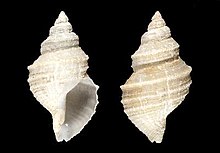Phymorhynchus cingulatus
Phymorhynchus cingulatus, common name the ringed turrid, is a species of sea snail, a marine gastropod mollusk in the family Raphitomidae.[1]
| Phymorhynchus cingulatus | |
|---|---|
 | |
| Original image of a shell of Phymorhynchus cingulatus | |
| Scientific classification | |
| Kingdom: | Animalia |
| Phylum: | Mollusca |
| Class: | Gastropoda |
| Clade: | Caenogastropoda |
| Clade: | Hypsogastropoda |
| Clade: | Neogastropoda |
| Superfamily: | Conoidea |
| Family: | Raphitomidae |
| Genus: | Phymorhynchus |
| Species: | P. cingulatus |
| Binomial name | |
| Phymorhynchus cingulatus (Dall, 1890) | |
| Synonyms[1] | |
| |
Description
The length of the shell attains 73 mm, its diameter 30 mm.
(Original description) The large, fusiform shell is of a rich reddish brown. It is deepest on the columella, with a closely adherent, very thin, polished epidermis. The shell contains seven whorls, without the protoconch, which is lost in the specimen, while the outer coat of the apical whorls is much eroded. The whorls are full and rouuded. The suture is distiuct, not appressed or channeled . The transverse sculpture consists only of fine inconspicuous lines of growth. The spiral sculpture consists of two sorts: first, a fine, sharp, slightly irregular striation, which covers the whole surface; secondly, of revolving elevated cinguli, of which three on the periphery are more widely and deeply separated and more elevated than the others. These three have interspaces equal to or wider than themselves. On the body whorl in front of the periphery the cinguli are flat-topped little elevated wide bands with narrower interspaces, this sculpture becoming obscure toward the siphonal canal. Above the periphery is one well-marked cingulum slightly turreting the whorl which inclines from it to the suture in a flattened manner. The aperture is pointed in front, wider behind. The columella is simple, perfectly straight, anteriorly attenuated. The body and columella show a thin dark brown glaze The outer lip is very thin, sharp, crenulated by the outside sculpture, which also grooves the interior The notch is shallow, wide; fasciole hardly visible; canal short, wide, hardly differentiated and straight. [2]
Distribution
This marine species occurs off Ecuador and the Galapagos Islands.
References
- Phymorhynchus cingulatus Warén & Bouchet, 2009. Retrieved through: World Register of Marine Species on 5 April 2010.
- Dall, W.H. (1890) Scientific results of explorations by the U.S. Fish Commission Steamer Albatross. No. VII – Preliminary report on the collection of Mollusca and Brachiopoda obtained in 1887–88. Proceedings of the United States National Museum, 12, 219–362, pls. 5–14
- Finet, Y. (1991) The Marine Mollusks of the Galapagos Islands. In: Galápagos Marine Invertebrate. Taxonomy, Biogeography, and Evolution in Darwin's Islands. Plenum Press. New York and London, p. 253-280.
- Keen, A.M. (1958) Sea Shells of Tropical West America. Stanford University Press, Palo Alto, 1st edition, 624 pp.
- Powell A. W. B. (1966). The molluscan families Speightiidae and Turridae. An evaluation of the valid taxa both Recent and fossil, with lists of characteristic species. Bulletin of the Auckland Institute and Museum 5: 1-184
- Finet, Y. (2001) The marine mollusks of the Galapagos Islands: a documented faunal list. Editions du Muséum d' Histoire naturelle, Genève, 237 pp
External links
- Tucker, J.K. (2004). "Catalog of recent and fossil turrids (Mollusca: Gastropoda)" (PDF). Zootaxa. 682: 1–1295.
- Gastropods.com: Phymorhynchus cingulatus
- Matthew J. James (2013), Galápagos Marine Invertebrates